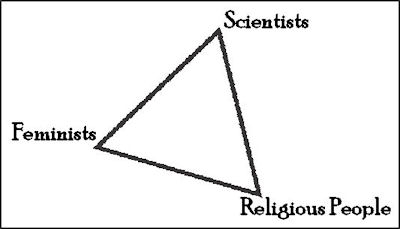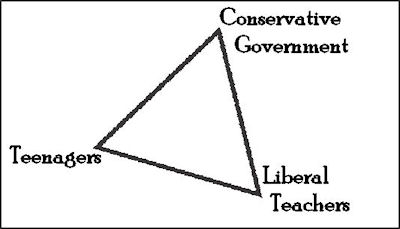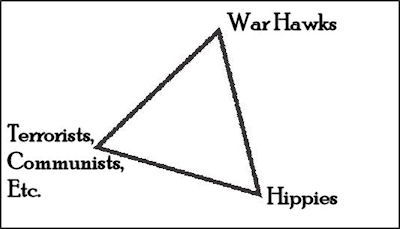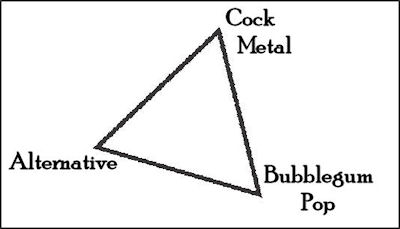|
The
Collapsible Triangle
Right? Well, it occurred to me that, like so much does in this universe, this may depend on where the observer is standing (philosophically speaking). And the more I thought about it over the subsequent weeks, the more argument situations I found that this model applies to. Picture it going on in physical space: you are standing between two tall buildings. You can plainly see that there is a good deal of physical space between them (obviously, since you are currently occupying that space). Now get a few blocks away: the distance between them seems shorter. Now get miles away, so that the buildings are on the horizon: the space between them has disappeared, to a point where they now appear to you to be one single building rather than two. You and the two buildings actually form a triangle, but from where you are standing, it appears to you that you form a straight line. Now
apply that
analogy to philosophy:
And
it’s not
like this is the only Philosophical Mexican Standoff (the thing in a
movie
where three people all draw guns on one another at the same time) where
the
analogy holds. Once you start running
with it, you can think of tons more.
It
even works
with art:
This model explains nothing about who is “right” regarding any of the issues to which it’s applied, of course. It isn’t supposed to. What it is supposed to do is help us examine the ways in which our philosophical oppositings aren’t as accurate as we think they are. Now, I’m certainly not pulling from the P.C. Playbook here and trying to say that there are no opposites (“the tyranny of the binary,” as a '90s Humanities Professor would have put it). Any of the hard sciences will inform you that the natural world has opposites coming out its ass (wherever that might be). But philosophy is not a hard science (i.e., although it is often “hard” in the sense of “difficult,” it is not one of the hard sciences, e.g., physics, chemistry). The hard sciences start with the external world and try to get information about it into our brains; philosophy starts with our brains and tries to get information about them into the external world (i.e., into books, whence into other people’s brains). And the flaw in talking about beliefs having opposites is that it rests on the assumption that human thought behaves like objects in three-dimensional spacetime (i.e., physical “real life” as we are used to seeing it). And this is rather arbitrary. Yes, the brain is a physical object operating in three-dimensional spacetime, as are all of its component parts and impulses, even the really really tiny ones, but thought itself — that is, being in the state of experiencing a thought — is not itself a physical operation, but rather the non-physical impression we get as a result. This
mistake is
understandable, since it is quite literally impossible for us to think
about
anything behaving in any other way. I
am
getting out of my depth here, but as I understand it, even Stephen
Hawking et
al cannot picture,
say, objects
operating in twelve-dimensional spacetime, but only perform the math
that
represents such operations (what we can picture mentally is limited by
how we
see, and although the brains of world-class physicists are very
different from
ours, their eyes are not). That is the
point of advanced math: it is a symbolic system that allows us to
communicate
at a level beyond the sense that observation is capable of making
(e.g., you
cannot see negative
five apples). In addition to helping us sharpen our own arguments, keeping the Collapsible Triangle in mind can help us disarm arguments unfairly leveled at us: “Maybe this person who’s pissed at me isn’t actually pissed at me, but rather is under the impression that I’m the same as some other people who I’m not really the same as, so my first move should be to figure out which other people she/he has in mind and distinguish myself from them.” You and the other person may still end up disagreeing about a lot, but at least you’ll both be directing the right arguments at the right person. It’s
also
beneficial because it
makes you more aware of “the
enemy of my enemy is my friend” situations and the
Machiavellian
allegiance-switching that they demand: in the ‘90s, feminists
and spiritualists
teamed up against logic, but then when the fundies got too powerful
under
George W. Bush, the rationalists and feminists teamed up against the
Religious
Right (and although no society has yet become matriarchal enough for
this to
happen on a grand scale, on certain college campuses it has become
necessary
for religious and rationalist students to work together to resist
feminist tyranny). This
process is a pain to people who wish
that one of the points on the triangle — i.e., their
own — would just win
already, but it is, I suppose,
comforting to those who like the idea of society eternally shifting to
remain “in
balance.” There are groups of three all over mythology, of course (the three Fates; the three Graces), and plenty of individual three-natured divinities (the Catholic Trinity; the Greek/Roman Hecate/Trivia, whose feast day it turns out was just the other day, August 13th, the day I started writing this essay). But those groups of three are all on the same side. I can’t find any examples of groups of three that all war against one another via eternally shifting alliances, except in two mythologies, both relatively recent: one is the three superstates of Oceania, Eurasia, and Eastasia in George Orwell’s 1984... …and
the other
is the third-rate '80s toy line Battle
Beasts. But I’m learning. |
read more awesome 1585 essays.
like and follow The 1585 on Facebook.
blog comments powered by Disqus



